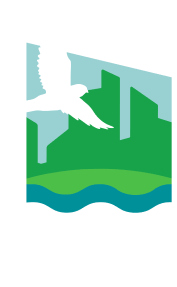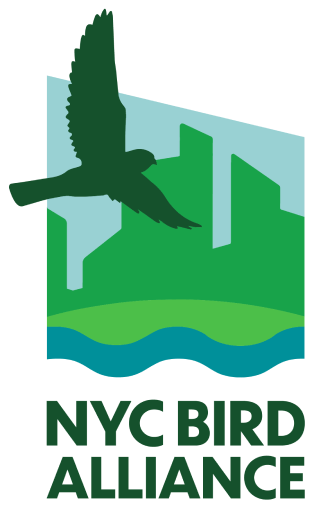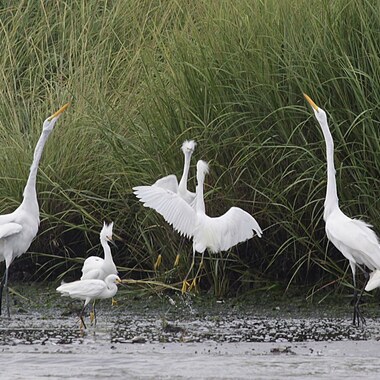
Great and Snowy Egrets display during breeding season in the Jamaica Bay Wildlife Refuge, Queens. Photo: Don Riepe
Harbor Herons
New York City is home to a hidden wilderness: the Harbor Heron islands. These protected sanctuaries provide safe nesting grounds for Great and Snowy Egrets, Black- and Yellow-crowned Night-Herons, Glossy Ibis, and Little Blue and Tricolored Herons. For over 40 years, NYC Bird Alliance has monitored and advocated for the protection of these birds and their habitat.
The history of the Harbor Herons program is in a sense the history of the Audubon Society itself: In the late 1800s, a movement began to stop the slaughter of egrets and herons for hat feathers, and the Audubon Society was born. The result of this conservation campaign was the Federal Migratory Bird Treaty Act of 1918, allowing wading bird populations to recover throughout the 20th century, with local birders discovering thriving egret colonies on Staten Island islands in the early 1970s.
The discovery of breeding wading birds in New York City jumpstarted much of NYC Bird Alliance's early habitat conservation work, with systematic annual surveys beginning in 1982 and continuing uninterrupted since 1985. Our data reveals both conservation successes and emerging threats, from climate impacts to habitat loss, making this work critical for protecting urban biodiversity. This research has directly informed our successful advocacy to preserve critical nesting islands throughout the harbor, and we continue our leadership role on the Harbor Herons Subcommittee of the NY/NJ Harbor Estuary Program, working to protect and restore our estuary.
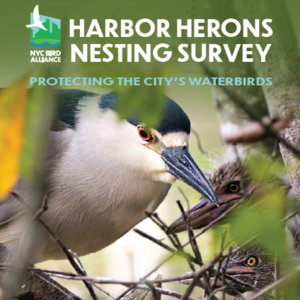
Cover of the 2024 Harbor Herons Nesting Report. Design: Tod Winston
Harbor Herons Nesting Survey Report 2024
Our 2024 Harbor Herons Nesting Survey marks 40 years of monitoring the largest population of colonial nesting wading birds in the northeastern United States, revealing both promising data and alarming declines. Explore our findings on the critical status of Black-crowned Night Herons and other wading bird species in New York Harbor.
Download report as PDF.
Download report as PDF.
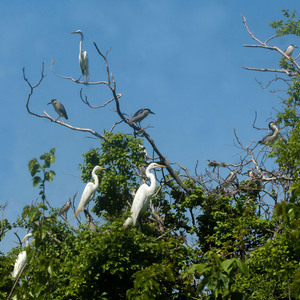
The Hoffman Island nesting colony includes Great and Snowy Egrets and Black-crowned Night-Herons, seen above, as well as Glossy Ibis, Double-crested Cormorants, and Great Black-backed and Herring Gulls. Photo: NYC Bird Alliance
Get to Know the Harbor Herons!
As many as 10 species of wading birds nest on New York City's Harbor Heron islands, along with cormorants and gulls, which NYC Bird Alliance also monitors during its annual survey of the islands. Get to know the colonial waterbird species that call our city home.
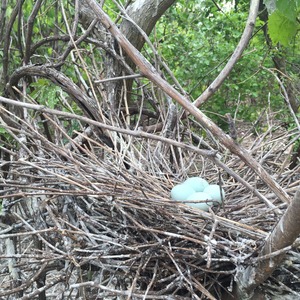
Snowy Egret nests like this one on South Brother Island are made of fine sticks and can host as many as six eggs. Photo: Christopher Girgenti
Nesting Surveys and Recent Conservation Efforts
Since 1982, NYC Bird Alliance has been monitoring the populations of wading birds (including herons, egrets, and ibis) and other waterbirds (cormorants, gulls, and terns) on select islands in the New York/New Jersey Harbor and surrounding waterways, while also noting the presence of other nesting bird species and current nesting habitat. In the second half of May each year, an enthusiastic corps of biologists, naturalists, and community scientists access each island via boat, quickly and systematically counting nests, eggs, and adults, while minimizing disturbance to the birds. More than 35 years of continuous data helps us determine what species or habitats are most in need of protection—and provides a critical benchmark for future research into the effects of climate change and environmental contaminants.
Nesting Survey Reports
Below, view or download reports from the Harbor Herons Nesting Survey project. (“Full Reports” document “full surveys”: every three years, we survey all islands that have hosted nesting waders during the entire history of the survey. Other years, we survey only islands where nesting occurred in the prior year; those surveys are documented in “Interim Reports."
- 2023 State of the Harbor Herons Report
- 2022 Full Report
- 2021 Interim Report
- 2019 Full Report
- 2018 Interim Report
- 2017 Interim Report
- 2016 Full Report
- 2015 Interim Report
- 2014 Interim Report
- 2013 Full Report
- 2012 Interim Report
- 2011 Interim Report
- 2010 Full Report
- 2009 Interim Report
- 2007 Full Report
- 2006 Interim Report
- 2005 Interim Report
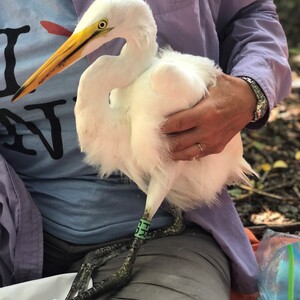
A fledgling Great Egret banded on South Brother Island in the Bronx. Photo: NYC Bird Alliance
Harbor Heron Banding Research
Since 2006, NYC Bird Alliance has banded and tagged nesting waterbird species on the Harbor Heron islands including Great Egret, Snowy Egret, Little Blue Heron, Glossy Ibis, and Double-crested Cormorant. Individually coded metal and large plastic “field-readable” bands allow us to identify individual birds and study the longevity, survival, migration, and dispersal of waterbird populations in New York Harbor. NYC Bird Alliance is participating in a global study of Glossy Ibis genetics, collecting feather samples from NYC-born Glossy Ibis, and recently published an article on Glossy Ibis nesting in the City for the inaugural issue of the research publication Stork, Ibis, and Spoonbill Conservation.
In recent years, new technologies have allowed us to track waterbird movement more continuously, via GPS technology. In collaborative research with 1000 Herons, New Jersey Audubon, and the U.S. Forest Service, we have tagged several Great Egrets and followed their movements.
Other Resources
The U.S. Army Corps of Engineers and The Port Authority of New York & New Jersey draft Comprehensive Restoration Plan for the Hudson-Raritan Estuary and the Harbor Herons Subcommittee of the Harbor Estuary Program’s Harbor Herons Conservation Plan together provide historical perspective of Harbor Herons and their breeding and foraging habitat, identify threats to the persistence of these species in the harbor, and lay out a plan of action for protecting these birds in the future.
THANK YOU TO OUR SUPPORTERS
NYC Bird Alliance’s Harbor Herons program is made possible through the support of the Robert F. Schumann Foundation, Jeniam Foundation, Hudson River Foundation, Sarah K. de Coizart Article TENTH Perpetual Charitable Trust, and Elizabeth Woods and Charles Denholm. Critical support is also provided by the generous contributions of our members and donors.
